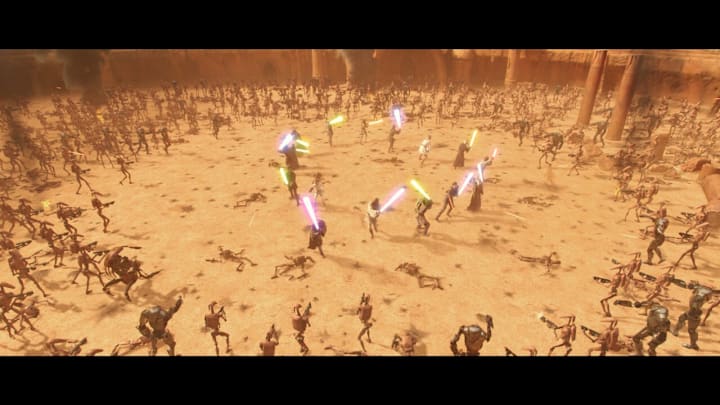I was 18 when the first of the Star Wars prequels came out, and honestly, the scale of the visual storytelling intrigued me the most from the start. I am the sort of person who would have gladly listened to Homer's epics had I lived in Ancient Greece. The thing I love about films has a lot to do with expanding my visual imagination. With that in mind, I checked out Lucasfilm Press' Star Wars: The Prequel Trilogy, A Graphic Novel by Alessandro Ferrari as soon as I found it at the library. I wanted to see if the storytelling would hold up in a static form.
WAR!
The thing I appreciated most about this adaptation is the economical use of page space for the battles. I can still hear John Williams' epic score, but there is heightened tension and a sense of "Well, that escalated quickly" in the liberation of Naboo in The Phantom Menace. The droids overwhelmed the Gungan forces with too much ease. There was a loss of ships during the attack on the droid control ship. In Revenge of the Sith, the mind-boggling complexity of the opening battle is well-portrayed both in crowded action panels and graphics of tableaux with fewer subjects but quickly focuses on the individual Jedi flying through the maelstrom to rescue the Chancellor. The depiction of Order 66 is, perhaps, my favorite sequence.
The one element that left me wanting was Geonosis. This is a pivotal and game-changing battle for the Republic and the Jedi Order. The adaptation showed a few Jedi fighting off battle droids, but none of the desperation and defeat. One of the most sobering moments of Episode II for me was Obi-Wan Kenobi stopping to check the pulse of a fallen Jedi as Count Dooku gloated over his inevitable destruction. If you've only read the graphic novels, you would think that very few casualties happened in that arena. Those who fell really deserved more.
Ready for a Close-up
These graphic novels do an excellent job of deciding when to zoom in on specific expressions and play with body language. The artists took some license to convey frustration and exhaustion because readers can't hear Anakin Skywalker's resentment of Obi-Wan's criticism. The intimacy that develops between Anakin and Padme Amidala in the second installment is particularly well done. They continue that excellence in Revenge of the Sith, but I feel that one of the best moments captured is the single-minded focus of Mace Windu killing Jango Fett.
On the other hand, this also sacrificed some characters. As mentioned before, most of the Geonosis task force didn't appear. Captain Tarpals, whose arc as a foil for the klutz-turned-general Jar Jar Binks, seems to have gone missing.
I don't get the reference
With so many positive aspects to the adaptations, I only have one major complaint. The prequels lost their personality in the process. The scenes were curtailed to further the storyline, which really helped at times. But George Lucas' projects have always relied on some humor and wry irony.
Putting aside that there weren't as many quotable moments, it made the dynamics less powerful. Padme snarks about aggressive negotiations, but we never see the scene where Anakin defines those. Obi-Wan doesn't have the same camaraderie with the clone troopers under his command. Most importantly, there is less grief expressed on Mustafar.
I definitely recommend these adaptations, but they may make you want to rewatch the movies to remember the rest of what made you love the stories in the first place.
